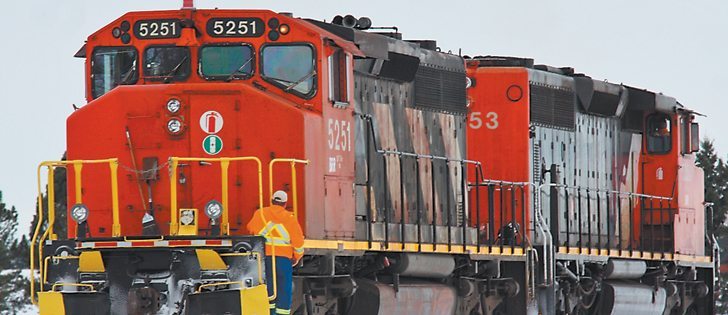Strong demand | Small line operators are also seeing an increase in oil and gas traffic
Canada’s major railway companies aren’t the only ones benefiting from Western Canada’s bumper crop.
Record grain volumes combined with increased rail demand from oil and gas industries are also generating solid revenues for short-line railway companies.
“We’re reaping some success right now because of all the problems that farmers are having,” said Lonnie McKague, a farmer and founding member of Red Coat Road and Rail, a short line that operates 115 kilometres of track between Pangman and Assiniboia in southern Saskatchewan.
“It’s hard for me to sit here and say that (our railway) is thriving and we’re doing great … but we are,” he said.
Read Also

Farming Smarter receives financial boost from Alberta government for potato research
Farming Smarter near Lethbridge got a boost to its research equipment, thanks to the Alberta government’s increase in funding for research associations.
“We’re going to be turning grain business away here and we already have been. We’re (getting that business) from people who are coming to us in desperation to try to get some grain moved and (generate) some cash flow.”
Traffic on Battle River Railway, which runs between Alliance and Camrose in northeastern Alberta, is also strong, said Howard Vincett, a founding director of BRR.
“We’re having a record year here … and we’re in the process of trying to lease some cars of our own,” said Vincett, who farms near Galahad, Alta., 200 km west of the Alberta-Saskatchewan border.
“We’ve had some grain move here from Saskatchewan, believe it or not. There’s been some flax move in from Saskatchewan and there’s been inquiries from as far away as Moose Jaw and Swift Current.… I guess it shows you how desperate guys are getting some places.”
Demand for rail capacity is strong across the West.
Oil traffic has increased on many smaller lines, and grain traffic is up as well, especially among farmers having trouble delivering grain to mainline elevator companies.
Statistics provided by Quorum Corp., which monitors prairie grain transportation, show the amount of grain in storage at mainline company elevators across the West surpassed 3.6 million tonnes late last month, which is almost full capacity.
Loading a hopper car has also be-come more appealing for farmers, especially with basis levels as they are.
Farmers can sometimes earn as much as $2 per bushel more by loading their grain into a producer car, Vincett said.
BRR is also handling more CWB grain.
“We’re finding that a lot of (CWB) business is actually coming to us instead of going to the elevator companies because the grain companies, I suspect, are making more money buying their own grain rather than moving CWB grain,” Vincett said.
“They don’t want to do the board grain so there’s been some grain companies actually pushing their CWB business to us.”
BRR moved about 700 hopper cars of board grain a year under single desk marketing, but the number of hopper cars hauling grain, oilseeds and pulses on BRR’s track has nearly doubled since the grain market was deregulated.
BRR has identified new domestic markets, including domestic flour mills in British Columbia’s Fraser Valley, livestock feeders and pea stuffers.
“I guess what we’re doing is we’re finding (new domestic) markets and anytime you can move grain there, it takes some pressure off going to export terminals… Basically, we have a wider range or places where grain can go.”
Officials at Red Coat Road & Rail have taken a similar approach.
McKague said the railway faced challenges when single desk marketing was eliminated in 2012.
With CWB grain volumes no longer assured, Red Coat and a subsidiary company, Ogema Elevator, began looking for new ways to market local grain.
The companies are now shipping flax out of Ogema every second week.
“We no longer had the CWB so we had to assist farmers by finding markets for them,” said McKague.
Demand for service is high, but short lines still depend on their big brothers at Canadian National Railway and Canadian Pacific Railway to deliver cars. But car spots have been hit and miss.
“Overall, we’re between four and nine weeks behind in grain car orders and for our little line, that’s a lot,” said McKague.
At BRR, car spots have also been unpredictable, said Vincett.
Car orders that go unfilled for weeks will appear on short notice. Short lines and loading facilities must be ready to respond quickly.
“Big rail is big rail,” said Vincett. “They’re the big dog and we’re the tail at the end. We’re adapting to the system and we’re making it work.”


















